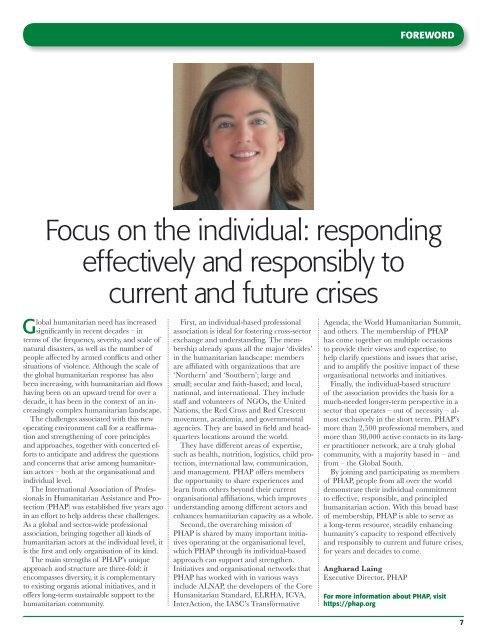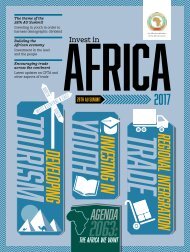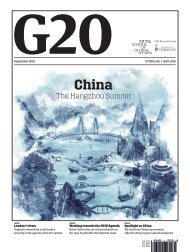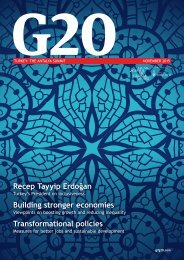SOURCE: Sustainable Development
SOURCE Sustainable Development magazine will be exploring the post 2015 international development landscape. It will engage the private sector to drive innovation and support the ever growing need to achieve the UN Sustainable Development goal’s
SOURCE Sustainable Development magazine
will be exploring the post 2015 international
development landscape.
It will engage the private sector to drive
innovation and support the ever growing
need to achieve the UN Sustainable
Development goal’s
Create successful ePaper yourself
Turn your PDF publications into a flip-book with our unique Google optimized e-Paper software.
FOREWORD<br />
Focus on the individual: responding<br />
effectively and responsibly to<br />
current and future crises<br />
Global humanitarian need has increased<br />
significantly in recent decades – in<br />
terms of the frequency, severity, and scale of<br />
natural disasters, as well as the number of<br />
people affected by armed conflicts and other<br />
situations of violence. Although the scale of<br />
the global humanitarian response has also<br />
been increasing, with humanitarian aid flows<br />
having been on an upward trend for over a<br />
decade, it has been in the context of an increasingly<br />
complex humanitarian landscape.<br />
The challenges associated with this new<br />
operating environment call for a reaffirmation<br />
and strengthening of core principles<br />
and approaches, together with concerted efforts<br />
to anticipate and address the questions<br />
and concerns that arise among humanitarian<br />
actors – both at the organisational and<br />
individual level.<br />
The International Association of Professionals<br />
in Humanitarian Assistance and Protection<br />
(PHAP) was established five years ago<br />
in an effort to help address these challenges.<br />
As a global and sector-wide professional<br />
association, bringing together all kinds of<br />
humanitarian actors at the individual level, it<br />
is the first and only organisation of its kind.<br />
The main strengths of PHAP’s unique<br />
approach and structure are three-fold: it<br />
encompasses diversity, it is complementary<br />
to existing organis ational initiatives, and it<br />
offers long-term sustainable support to the<br />
humanitarian community.<br />
First, an individual-based professional<br />
association is ideal for fostering cross-sector<br />
exchange and understanding. The membership<br />
already spans all the major ‘divides’<br />
in the humanitarian landscape: members<br />
are affiliated with organizations that are<br />
‘Northern’ and ‘Southern’; large and<br />
small; secular and faith-based; and local,<br />
national, and international. They include<br />
staff and volunteers of NGOs, the United<br />
Nations, the Red Cross and Red Crescent<br />
movement, academia, and governmental<br />
agencies. They are based in field and headquarters<br />
locations around the world.<br />
They have different areas of expertise,<br />
such as health, nutrition, logistics, child protection,<br />
international law, communication,<br />
and management. PHAP offers members<br />
the opportunity to share experiences and<br />
learn from others beyond their current<br />
organisational affiliations, which improves<br />
understanding among different actors and<br />
enhances humanitarian capacity as a whole.<br />
Second, the overarching mission of<br />
PHAP is shared by many important initiatives<br />
operating at the organisational level,<br />
which PHAP through its individual-based<br />
approach can support and strengthen.<br />
Initiatives and organisational networks that<br />
PHAP has worked with in various ways<br />
include ALNAP, the developers of the Core<br />
Humanitarian Standard, ELRHA, ICVA,<br />
InterAction, the IASC’s Transformative<br />
Agenda, the World Humanitarian Summit,<br />
and others. The membership of PHAP<br />
has come together on multiple occasions<br />
to provide their views and expertise, to<br />
help clarify questions and issues that arise,<br />
and to amplify the positive impact of these<br />
organisational networks and initiatives.<br />
Finally, the individual-based structure<br />
of the association provides the basis for a<br />
much-needed longer-term perspective in a<br />
sector that operates – out of necessity – almost<br />
exclusively in the short term. PHAP’s<br />
more than 2,500 professional members, and<br />
more than 30,000 active contacts in its larger<br />
practitioner network, are a truly global<br />
community, with a majority based in – and<br />
from – the Global South.<br />
By joining and participating as members<br />
of PHAP, people from all over the world<br />
demonstrate their individual commitment<br />
to effective, responsible, and principled<br />
humanitarian action. With this broad base<br />
of membership, PHAP is able to serve as<br />
a long-term resource, steadily enhancing<br />
humanity’s capacity to respond effectively<br />
and responsibly to current and future crises,<br />
for years and decades to come.<br />
Angharad Laing<br />
Executive Director, PHAP<br />
For more information about PHAP, visit<br />
https://phap.org<br />
7<br />
SDD_Laing_Foreword.indd 7 04/03/2015 13:52
















